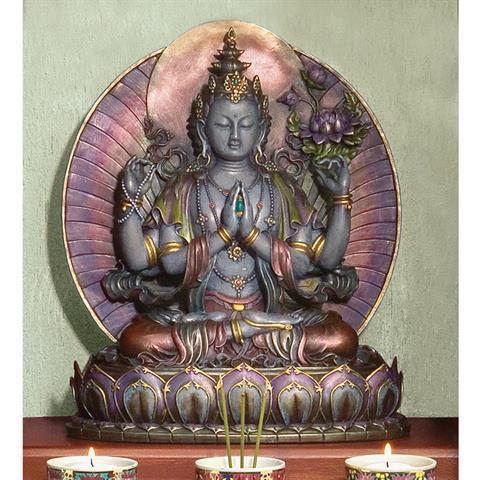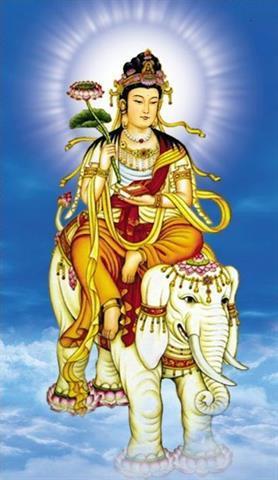SAMANTABHADRA
Contents
. Introduction
. Meaning and Origin
. Iconography
. In China
. In Japan
. In Tibet
. In Sri Lanka
. Sutras
. Hymn in praise of Samantabhadra
. Conclusion
Introduction
 Boddhisattvas are beings who withhold their own enlightenment in order to help all sentient beings to transcend suffering. Inspite of it being a tough endeavour, the Boddisattvas unlimited compassion and wisdom voluntarily compels them to respond to the pain of others and saving them from the consequences of their negative Karma is one of their main goals in life.
Boddhisattvas are beings who withhold their own enlightenment in order to help all sentient beings to transcend suffering. Inspite of it being a tough endeavour, the Boddisattvas unlimited compassion and wisdom voluntarily compels them to respond to the pain of others and saving them from the consequences of their negative Karma is one of their main goals in life.
Meaning and Origin
Samantabhadra is one of the eight great Boddhisattvas and his name means Universal Virtue or Universally Extending Virtue or Universal Worthy which implies that he extends his compassion to all sentient beings to perfect their virtues. Samantabhadra emphasizes on the aspect of practice and asks the Buddha to teach the stages of practice which all beings can begin with. The relationship of practice and understanding is similar to oil and flame and to assimilate the Buddhist teachings, both understanding and practice of the teachings is essential. He is also called the Boddhisattva of Great Practice.
Iconography
Samantabhadra is generally shown in images as part of a trinity along with Buddha and Manjushri Boddhisattva. He is usually shown riding a six tusked white elephant where the six tusks represent the six senses and riding on it shows overcoming attachment to it. The six tusks also represent the paramitas or the six perfections namely morality, patience, charity, contemplation, diligence and wisdom. These are the six ways that are to be practised to attain enlightenment.
Some believe that the white elephant is similar to the elephant that appeared to Maya Devi, the mother of Buddha to herald his birth.
In China
In China Samantabhadra is referred to as Pu Hsien or Puxian and is generally shown in a feminine form though sometimes also worshipped in a male form. In the female form, she is said to be the embodiment of patience, love, sacred activity, diligence and virtue. She is shown seated on a white elephant holding a lotus or a book or a scroll. The elephant may be standing or crouching and may have either three heads or one head with six tusks. She is generally depicted in images in a triad with Buddha and Wen-Shu-Pusa(Manjushri).
In The Pu Hsein Fusa(Sutra of Meditation on the Bodhisattva Universal Virtue), the Buddha praises her stating that anyone who practices this meditation will acquire great merits, will be free from all hindrances and will be able to see her in various forms. Extolling her, the Buddha even declares that He would protect and guard all those who pray and recite the name of Boddhisattva Universal Virtue or Pu Hsein.
A number of female devotees are attracted to her but temples dedicated to her are quite scarce as she is not generally worshipped by the average Buddhist and it is said that only those who have a karmic link with her venerate her. The popular prayer for her is ‘Namo Ta Hung Pu Hsein Fusn’. Her festival is celebrated on the 21st day of the second moon of the Chinese calendar.
The temple devoted to Pu Hsein was built by a Chinese Buddhist monk Hui-Chih on the O-Mei mountain in the Xhsi-Thuan province of China in 399 AD which has become a sacred site for pilgrims.
In Japan
Samantabhadra is referred to as Fugen Bosatsu in Japan. His image appears in a triad with Buddha and Monju Bosatsu(Manjushri). He is positioned in a Eight petal Court with a lotus in the left hand surmounted with a sword and in Monju Court with a lotus in the left hand topped with a three pronged Vajra.
Fugen is referred to as the ‘Great Conduct Boddhisatva’. He teaches that conduct and behaviour are equal in importance to meditation and thought. He is referred to as the Bodhisattva of practice and the Patron of Women.
The 14th day of each month is considered Fugen’s Ennichi or Fugen’s Holy Day.

In Tibet
He is referred to as Kuntuzangpo in Tibet and is considered as the primordial Buddha. He is the unity of awareness and is not subjected to limits of time, physical conditions or place.
In Sri Lanka
Samantabhadra is venerated here as Saman or Suman meaning the rising morning sun. He is considered as one of the guardian deities of Buddhism and the island and his main shrine is located at Ratnapura where in his honour an annual festival is held.

Sutras
The ten great vows that are made by Samantabhadra for Buddhist practice and which are said to be the leading guidelines of all Boddhisattvas and recorded in the Avatamsaka Sutra are-
1.To praise all Buddhas.
2. To respect and pay homage to them
3.To make offerings to Buddha, the offering actually represented being the practice of the Buddhist teachings in order to help ourselves and others.
4.To rejoice in others virtues and merits.
5.To reform and repent for all our evil karmas.
6.To pray that the teachings of the Buddha will be passed on from generation to generation.
7. To pray that the Buddhas remain in the world so that more and more people can be benefited by them.
8.To always follow the Buddha’s teachings at all times and in all circumstances.
9.To respect all beings and live in harmony with them.
10.To transfer all merits and virtues to all beings to help them in their path to salvation.
In the last chapter of the Avatamsaka Sutra named Gandavyuha Sutra, the student Sudhana meets the Boddhisattva Samantabhadra who teaches him that wisdom is useful and beneficial to all living beings only if it is put into practice.
In the Lotus Sutra, the epilogue called the Samantabhadra Meditation Sutra gives in detail the visualisation of Samantabhadra and the virtues of devotion to him.

Hymn in praise of Samantabhadra
The Bodhisattva of Great Conduct is called Universal Worthy,
The sea of his vow power is multi-layered without bounds.
With dignity he reposes upon a six-tusked elephant;
By wisdom he is born, transformationally from a lotus of the seven gems.
In all samadhis he attains sovereignty,
His originally wonderful virtue is pervasive and perfected.
Praises of his jeweled awesomeness arrives to teach the Saha world;
His efficacious response and spiritual powers shake the great-thousand realm.
Homage to Universal Worthy Bodhisattva of Great Conduct, who dwells in the Silver World of E Mei Mountain

Conclusion
Worship of Samantabhadra Boddhisattva is said to grant energy and perseverance in the practice of the six paramitas or perfections. He represents the principle of universal love and is also known as the Boddhisattva of Great Activity. He made the ten great vows which are the basis of a Bodhisattva and is the Protector of those who teach the Buddhist Dharma. He is sometimes depicted as a man and sometimes as a woman. Great beings like him are born only for the welfare of mankind and help them to cross the cycles of birth and death and transcend suffering and gain ultimate liberation.
1. Wikipedia.com
2. Buddhisma2z.com
3. Buddhanet.net
4. Buddhism.about.com
5. Dharma-haven.org
6. cttbusa.org
7. wildmind.org
8. manjushri.com
9. urbandharma.org
10. buddhismnow.com
